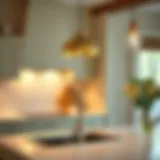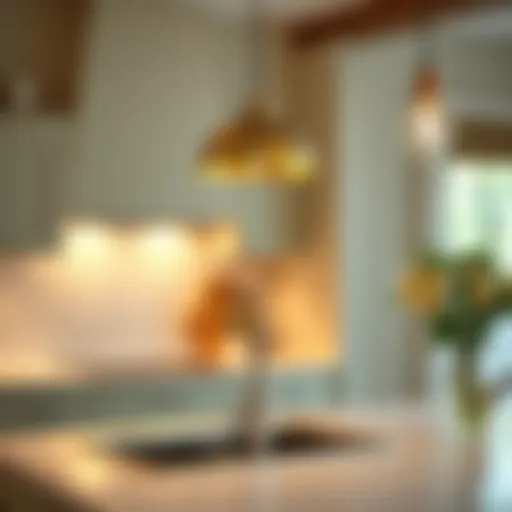Level 1 Kitchen Cabinets: Functionality Meets Design


Intro
In the realm of modern interior design, kitchen cabinets significantly influence both functionality and aesthetic appeal. Among various options available, Level 1 kitchen cabinets stand out for those who seek a balance between practicality and stylistic expression. This article delves into the multi-faceted aspects of these cabinets, from their design options to material selection, color schemes, and installation practices. Understanding these components can empower homeowners, design enthusiasts, and social hosts to create kitchen spaces that remain efficient and visually enticing.
Design Inspirations
Trending Styles
Designing Level 1 kitchen cabinets often involves selecting styles that cater to contemporary preferences. Among popular options are shaker cabinets, known for their clean lines and minimalist appeal. They usually feature a simple frame and flat panel, providing versatility with different finishes.
Flat-panel cabinets invite a sleek appearance, fitting a modern aesthetic perfectly. They can be customized with various materials, enhancing their contemporary vibe. On the other hand, traditional styles often incorporate intricate moldings and detailed finishes. This combination can satisfy those who appreciate classic designs while maintaining functionality.
Color Palettes
The choice of color makes a substantial impact on the kitchen's overall atmosphere. Neutral tones like white, grey, and beige are widely favored for their timeless appeal and ability to blend seamlessly into various design concepts. However, incorporating bold colors can create focal points or serve as playful accents.
Dark colors, such as navy blue or forest green, can imbue a space with sophistication. One should contemplate how these colors interplay with other kitchen elements—walls, countertops, and flooring—to establish a cohesive look.
"The spirit of the kitchen is reflected through its colors and materials; a strong selection offers both functionality and style."
Maintenance and Upkeep
Seasonal Maintenance Checklist
To ensure Level 1 kitchen cabinets remain in excellent condition, a seasonal maintenance checklist can be beneficial. This should include:
- Inspecting doors and drawers for proper alignment and function.
- Cleaning surfaces with suitable products to maintain their appearance, preventing damage.
- Checking hardware, such as hinges and knobs, for wear and tear.
- Assessing the finish for any signs of chipping or fading, which can indicate a need for refinishing.
Cleaning and Organization Tips
Keeping the kitchen organized and clean facilitates an efficient cooking space. Utilize clear containers for small items within cabinets to enhance visibility and accessibility. Regularly declutter the space helps maintain order. For cleaning, a solution of mild soap and water can be applied to surfaces, followed by a soft cloth to avoid scratches.
Cabinets can affect spatial perception—well-organized cabinets make the kitchen seem larger and more inviting. These factors are crucial in choosing Level 1 cabinets that truly enhance a home's cooking environment.
Through this exploration, it becomes evident that Level 1 kitchen cabinets are more than mere storage solutions; they reflect individual style and functional needs. Making informed decisions about their design, color, and maintenance is vital for reaping long-term benefits.
Prologue to Level Kitchen Cabinets
Level 1 kitchen cabinets serve as an essential component in modern kitchen design. Their role is not just to offer storage but also to complement the overall aesthetic of the space. Understanding the significance of these cabinets allows homeowners and designers to prioritize functionality without sacrificing style. This is particularly pertinent in smaller kitchens where effective use of space is crucial.
Defining Level Kitchen Cabinets
Level 1 kitchen cabinets typically refer to the more accessible range of cabinetry that balances affordability and quality. These cabinets can consist of a variety of materials, including plywood and MDF, often featuring a laminate or veneer finishing. Their design tends to prioritize straightforward construction paired with practical features such as easy installation. Thus, Level 1 cabinets fulfill the need for practical storage solutions while catering to budget constraints.
Importance in Kitchen Design
The role of Level 1 kitchen cabinets extends beyond mere aesthetics. They play a vital part in maximizing storage efficiency. A well-designed cabinet system can make a significant difference in the usability of kitchen space. Additionally, the selection of styles and finishes impacts the visual appeal of the kitchen, contributing to a cohesive look. For many homeowners, kitchen renovations hinge on the choices made in cabinetry, affecting both day-to-day functionality and long-term value.
"A well-thought-out cabinetry design enhances kitchen workflow, making cooking a more enjoyable experience."
In summary, Level 1 kitchen cabinets provide an intersection of style and utility, making them a foundational element in kitchen design.
Functionality of Level Kitchen Cabinets
Functionality is a cornerstone in the realm of kitchen design, especially regarding Level 1 kitchen cabinets. These cabinets must serve their primary purpose while complementing the kitchen's visual appeal. The blend of practicality and aesthetics is integral for ensuring that the cabinets not only look good but also meet the everyday needs of users. A well-designed kitchen cabinet increases efficiency, saving both time and energy in meal preparations and other kitchen activities.
Storage Solutions
When it comes to kitchen cabinetry, effective storage solutions are paramount. Level 1 kitchen cabinets typically come equipped with a variety of storage features that maximize space usage. Here are some key aspects:
- Adjustable Shelves: These allow homeowners to modify shelf heights according to their storage needs, accommodating taller items such as mixers and pots.
- Deep Drawers: Ideal for organizing utensils and larger kitchen tools, deep drawers provide easy access and visibility.
- Corner Solutions: Many designs utilize lazy Susans or pull-out cabinets to make corner spaces more functional. This prevents wasted space and ensures all items are easily reachable.
This flexibility in storage configurations enhances overall kitchen functionality. Homeowners can customize their storage based on personal habits and item types, which leads to an organized and efficient cooking environment.
Accessibility Considerations
Accessibility in kitchen design goes beyond the physical reach of cabinet contents; it encompasses the ease with which users can use these cabinets. Level 1 kitchen cabinets, when designed with accessibility in mind, can significantly improve daily kitchen activities. Specific considerations include:
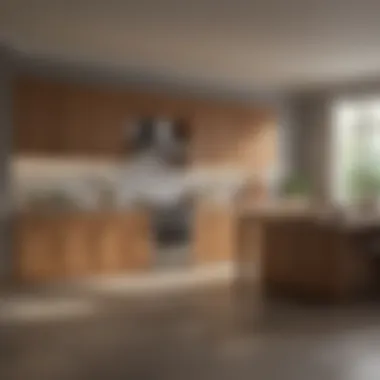

- Pull-Out Shelves: This feature allows for easier access to items stored at the back of cabinets, reducing the need for bending or stretching.
- Soft-Close Mechanisms: These enhance usability by preventing slamming doors, which is especially beneficial for children or individuals with limited hand strength.
- Open Shelving Options: Open designs can encourage easy visibility and access to frequently used items while reducing the need for cumbersome hardware.
By addressing these accessibility factors, homeowners can create an inclusive kitchen environment. This approach caters to users of all ages and abilities, enhancing the overall kitchen experience and making it a more inviting space.
Design Options for Level Kitchen Cabinets
Design options play an essential role in creating Level 1 kitchen cabinets. Selecting the right materials, colors, and styles can significantly impact both functionality and aesthetics. These choices affect how well the cabinets blend with other elements in the kitchen, how they perform daily tasks, and the overall visual appeal of the space. An informed decision-making process can lead to a kitchen that enhances everyday experiences and accommodates the needs of the household effectively.
Material Selections
Different materials have varied impacts on durability, maintenance, and visual appeal in kitchen cabinets. That is why material selection is crucial for both function and style.
Wood Types
Wood types deliver warmth and a natural aesthetic to Level 1 kitchen cabinets. Solid woods, such as oak or maple, provide strength and longevity. They are widely favored because they can take on various finishes, allowing customization for different designs. A unique feature of wood is its ability to withstand time, though it may require more maintenance compared to other materials. However, wood can be susceptible to humidity and may expand or warp if not properly treated.
Laminate Options
Laminate options are popular for their versatility and wide range of designs. They can mimic the look of wood and even stone, providing a stylish yet budget-friendly choice. A key characteristic of laminate is its resistance to scratches and stains, making it practical for busy kitchens. Nonetheless, laminate may not have the same long-term durability as solid wood and can be challenging to repair if damaged.
Metal Cabinetry
Metal cabinetry brings a modern edge to kitchen design. Stainless steel cabinets are particularly favored for their clean look and robust nature. The unique feature of metal is its cleanliness and ease of maintenance, as it resists bacteria and can be easily wiped down. However, it's important to consider that metal surfaces can be easily scratched or dented.
Color Schemes
Color schemes significantly influence the kitchen's mood and design coherence. Choices range from neutral to bold tones, each presenting opportunities to create different atmospheres.
Neutral Tones
Neutral tones such as whites and grays create a timeless look and are versatile for any kitchen style. They reflect light and promote a sense of space, making them a popular choice. The unique feature is their ability to adapt to changing decor. The downside is that they can sometimes feel bland if not balanced with colorful accents.
Bold Colors
Bold colors can add personality and energy to a kitchen. Rich blues or striking reds can become focal points, stimulating engagement. Their key characteristic lies in their ability to stand out. However, making a commitment to vibrant colors requires consideration of how well they will integrate with other design elements.
Natural Finishes
Natural finishes highlight the raw beauty of materials used in cabinets. This choice supports sustainability while emphasizing individuality. The unique characteristic of natural finishes is that they are less processed, allowing textures and grains to tell a story. On the downside, these finishes may require more upkeep to maintain their visual appeal over time.
Style Trends
Deciding on a specific style trend enables homeowners to express their individuality while ensuring their cabinets function safely and effectively.
Minimalist Designs
Minimalist designs favor clean lines, simplicity, and practicality. This approach allows for functional space while avoiding cluttered looks. Its key advantage is that it can create an open and airy feeling in the kitchen. However, one must ensure that a minimalist design does not sacrifice utility for aesthetics.
Traditional Aesthetics
Traditional aesthetics draw from classic designs. Ornate details and rich wood tones are central to this style. This is beneficial for those who appreciate craftsmanship and history. However, traditional styles might not always suit modern homes that favor sleek, modern designs.
Contemporary Looks
Contemporary looks reflect current trends and innovation. They often incorporate a mix of textures and bold patterns. Their key characteristic is flexibility, allowing for updates as trends evolve. That said, keeping with contemporary styles may require frequent changes to keep the look fresh.
"Design choices can transform the kitchen from a mere cooking space to a functional work of art."
In summary, selecting the right design options for Level 1 kitchen cabinets involves a careful assessment of materials, color schemes, and style trends. These decisions not only affect how cabinets perform but also how they contribute to the overall kitchen atmosphere.
Hardware and Accessories
Hardware and accessories play a critical role in the overall functionality and aesthetic of Level 1 kitchen cabinets. They are the finishing touches that can elevate the design while improving usability in various ways. Choosing the right elements can enhance the flow of the kitchen and provide practical benefits that save time and effort. This section explores them in depth, focusing particularly on handles and knobs, soft-close hinges, and pull-out features.
Handles and Knobs
Handles and knobs are among the most noticeable hardware items in any kitchen. Their design can significantly impact the look of cabinets. Homeowners have a vast array of options when it comes to style, shape, and finish. Selecting the right handles or knobs involves more than mere aesthetics. It is essential to consider comfort and ease of use as well. Accessories should feel good to use, especially in a busy kitchen.
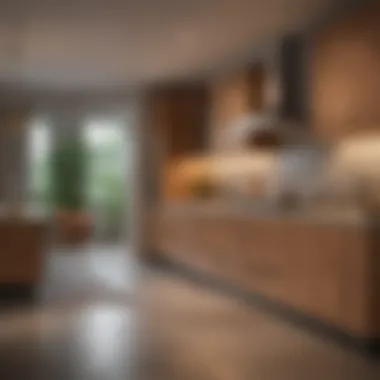

Some popular choices include:
- Stainless Steel: Known for its durability and modern look.
- Brass: Offers a warm, vintage feel.
- Ceramic or Porcelain: Adds a touch of color and can complement specific design themes.
When contemplating handles and knobs, one should also consider the scale and placement. Oversized handles may dominate a small kitchen, while delicate knobs might get lost on larger cabinets. Therefore, the choice should match both the cabinet style and kitchen size, ensuring a cohesive look throughout the space.
Soft-Close Hinges
Soft-close hinges are an innovative addition that enhances the functionality of kitchen cabinets. They allow doors to close smoothly and quietly, maintaining a serene kitchen environment. The mechanism prevents slamming, which not only protects the cabinets from damage but also reduces noise. In homes with young children, these hinges offer extra safety, minimizing the risk of fingers getting caught in closing doors.
Installation of soft-close hinges can typically be completed without professional help, making them a suitable option for DIY enthusiasts. However, it is crucial to select high-quality hinges to ensure longevity and proper functionality. Opting for reliable brands may incur a higher upfront cost, but they often prove to be a worthwhile investment.
"Soft-close technology not only enhances the luxury of cabinets but significantly contributes to their longevity."
Pull-Out Features
Pull-out features are a game-changer when it comes to kitchen organization. These accessories allow homeowners to make the most of cabinet space, particularly in deeper areas that might otherwise be difficult to access. Popular options include pull-out shelves, spice racks, and garbage bins.
Benefits of implementing pull-out features include:
- Enhanced Accessibility: Users can easily reach the back of cabinets without bending or stretching.
- Organized Storage: Items can be organized clearly, reducing clutter and improving efficiency during cooking and cleanup.
- Customized Solutions: Many manufacturers offer various configurations, enabling homeowners to tailor the features to their specific needs.
When choosing pull-out features, consider the cabinet's layout and the types of items commonly used in the kitchen. For a streamlined look, integrate these features with cabinet interiors to enhance both functionality and design coherence.
Installation Considerations
Installation is a critical phase in the process of integrating Level 1 kitchen cabinets into any kitchen space. Proper installation not only ensures functionality but also affects the overall aesthetics of the kitchen. The design, placement, and fitting of cabinets can influence how the kitchen is accessed and utilized, which is vital for efficiency in cooking and daily routines.
Understanding the installation process can aid homeowners and designers in achieving a polished and cohesive look. When cabinets are installed correctly, they can enhance the visual appeal and provide much-needed storage and accessibility. Additionally, proper installation can prevent common issues, such as misalignment and gaps, which could lead to complications over time.
Professional vs. DIY Installation
Choosing between professional installation and a DIY approach is essential for the success of your kitchen cabinets. Both options have advantages and drawbacks.
Professional Installation
Hiring a professional can ensure accuracy and quality. Experts have the training and tools required for precise measurements and fittings. They can navigate unexpected challenges, such as uneven walls or plumbing installations, which can complicate the process. Many professionals also offer warranties for their work, providing peace of mind.
On the downside, professional installation can be costly. Homeowners must consider their budget and whether full-service installation fits into their renovation plans.
DIY Installation
Opting for a DIY installation can save money and allow for personal involvement in the project. Many homeowners find satisfaction in completing such tasks themselves.
However, DIY installations come with risks. Errors in measurement or assembly can lead to misaligned cabinets, which impacts both functionality and aesthetic appeal. Those without experience might find the task challenging, leading to frustration and potential delays. It's prudent to evaluate one’s skills and comfort level before committing to this path.
Measuring for Fit
Proper measurement is paramount when installing Level 1 kitchen cabinets. Accurate measurements can prevent fitting issues that may arise during installation. To ensure cabinets fit seamlessly into the designated space, here are some key aspects to consider:
- Measure the Wall Space: Goals include determining the total length and height available for installation. Take multiple measurements to account for any irregularities in the walls.
- Check for Obstacles: Identify any appliances, pipes, or light switches that may obstruct cabinet installation. It's necessary to factor these into your cabinet layout.
- Determine Cabinet Depth: Cabinets come in various depths. Select the depth appropriate for your kitchen layout to maintain a balanced look and function.
- Use a Level: Ensuring measurements are consistent is critical for installation. Leveling helps in maintaining even cabinet alignment.
Accurate measuring lays the foundation for effective cabinet installation, preventing future complications.
In summary, the installation of Level 1 kitchen cabinets involves significant considerations, particularly the choice between professional services and DIY approaches. It also emphasizes the importance of precise measurements to achieve a functional and visually appealing kitchen. Balancing these factors can greatly enhance the outcome of your kitchen project.
Maintenance of Kitchen Cabinets
The longevity and appearance of kitchen cabinets rely significantly on proper maintenance. Level 1 kitchen cabinets are exposed to daily wear and tear, making maintenance essential. This section focuses on cleaning techniques and preventative care, both critical for maintaining the aesthetics and functionality of your cabinets.
Cleaning Techniques
To keep kitchen cabinets looking their best, regular cleaning is vital. Dust, grease, and food particles can accumulate, potentially harming the finish. Here are some effective cleaning techniques:
- Gentle Solutions: Use mild soap mixed with water. Avoid harsh chemicals that can damage the surface.
- Soft Cloths: Microfiber cloths are ideal for cleaning. They are effective in capturing dirt without scratching the finish.
- Spot Cleaning: For tougher stains, spot clean using a mixture of vinegar and water. Apply it lightly on the affected area. Rinse with a damp cloth after treatment.
- Avoid Excess Moisture: Always dry your cabinets after cleaning. Excess moisture can lead to warping and damage.
Preventative Care
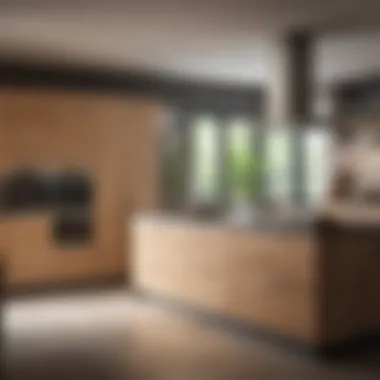

Preventative care is as important as cleaning. Taking proactive steps helps to preserve the integrity of kitchen cabinets. Consider the following strategies:
- Regular Inspections: Check for signs of wear such as scratches or dents. Address these issues before they worsen.
- Refrain from Excessive Heat: Avoid placing hot items directly on cabinet surfaces. Use trivets or mats to protect the finish.
- Humidity Control: Excess moisture can damage wooden cabinets. Use dehumidifiers if necessary, especially in humid climates.
- Frequent Touch-Ups: Utilize touch-up kits for small scratches or blemishes. This small effort keeps cabinets looking new.
Maintaining your kitchen cabinets is not just about cleaning; it's also about adopting habits that prolong their life and beauty.
By implementing these cleaning techniques and preventative care measures, homeowners can preserve the functionality and aesthetic appeal of their Level 1 kitchen cabinets.
Impact on Kitchen Spatial Dynamics
Understanding the impact of kitchen cabinets on spatial dynamics is crucial in modern kitchen design. Kitchen cabinets are not merely containers for storage. They play an essential role in defining how space is utilized and perceived. By considering the geometry of a kitchen, homeowners can make informed decisions that enhance usability and aesthetics.
Creating Visual Balance
Visual balance in a kitchen is vital for creating an environment that feels cohesive and inviting. Level 1 kitchen cabinets can influence visual weight. For instance, cabinets that are uniformly colored and aligned can help create a sense of harmony in the space.
Consider these elements for achieving visual balance:
- Cabinet heights: Taller cabinets can draw the eye upward, creating an illusion of more space.
- Color coordination: Matching cabinet colors with walls or counters can create a seamless look.
- Symmetry: Arranging cabinets in symmetrical patterns can enhance the overall visual appeal.
Incorporating these principles will aid in making a kitchen not only functional but also aesthetically pleasing.
Optimizing Workflow
Optimizing workflow in a kitchen involves arranging cabinets to support efficient movement during cooking and preparation. The goal is to minimize unnecessary steps while cooking meals. An effective layout might include placing cabinets for pots and pans near the stove and utensils handy in the vicinity of food prep spaces.
To think about optimizing workflow, consider the following factors:
- Triangle layout: The kitchen triangle, which connects the sink, stove, and refrigerator, is a long-established design principle. By arranging cabinets within this layout, homeowners can facilitate an efficient cooking process.
- Accessibility of items: Items that are used frequently should be stored within easy reach.
- Flow of movement: The placement of cabinets should allow for smooth transitions between different cooking tasks.
Understanding spatial dynamics will enable homeowners to create kitchens where both functionality and aesthetic can thrive.
Future Trends in Kitchen Cabinetry
The kitchen is evolving. Homeowners, designers, and industry professionals are recognizing new ways to improve kitchen functionality and aesthetics. Future trends in kitchen cabinetry encompass sustainability and smart technology integration. These elements not only enhance the design but also offer advantages in usability and environmental responsibility. It matters because it reflects values and necessities of modern life.
Sustainability Practices
Sustainability continues to be a prominent focus across many industries, and cabinetry is no exception. Homeowners today lean towards solutions that are environmentally friendly. Manufacturers are responding by adopting practices that reduce waste and utilize renewable materials. Some examples include cabinetry made from recycled wood or low-VOC finishes that lessen harmful airborne pollutants.
Adopting sustainable practices in kitchen cabinetry offers several benefits:
- Healthier Environment: Using eco-friendly materials contributes to better indoor air quality.
- Durability: Sustainable materials tend to be more robust, ensuring prolonged use which is economically and environmentally sound.
- Market Value: Homes that feature sustainable features are often viewed more favorably in the real estate market.
Considerations for sustainability cannot be overstated. When choosing sustainable options, look out for certifications like the Forest Stewardship Council (FSC) label. Also, remember to consider the source of materials. Local sourcing reduces transportation emissions and supports the community.
Smart Technology Integration
Smart technology is increasingly taking a central role in kitchen design. Kitchen cabinetry is not just about storage anymore; it now integrates technology for enhanced functionality. Features such as touch-activated lighting, hidden chargers, and even cabinets that can communicate with other smart home devices are becoming standard.
Some significant advantages of smart technology integration include:
- Convenience: Smart cabinets can automate tasks, making kitchen workflows smoother.
- Space Utilization: Technology can help maximize storage by providing innovative solutions.
- Efficiency: Smart systems optimize energy use, reducing costs over time.
When considering smart technology, it is essential to ensure compatibility with existing appliances and devices. The integration should not complicate kitchen functions but, instead, enhance them seamlessly.
In summary, trends in kitchen cabinetry reflect a clear directive towards sustainable living and tech-savvy designs that elevate functionality and aesthetics. Understanding these trends helps homeowners make informed choices. The future of kitchen cabinetry is all about creating spaces that are not only beautiful but also environmentally conscious and efficient.
Ending
The topic of concluding insights on Level 1 kitchen cabinets is essential in understanding their role in modern kitchen design. It not only encapsulates the information discussed but also emphasizes the practical and aesthetic functions these cabinets serve. By assessing their design elements and how they integrate into one’s kitchen, homeowners can make more informed decisions.
Summary of Key Takeaways
In summary, here are the key points to consider:
- Functionality: Level 1 kitchen cabinets should focus on maximizing storage while ensuring ease of access. The selection of appropriate hardware and installation methods can significantly enhance usability.
- Design Options: Choices of materials, color schemes, and styles are crucial in harmonizing the cabinets with the overall kitchen theme. Options vary widely, from classic wood finishes to modern laminates.
- Installation: Correct installation is critical for both safety and effectiveness. Homeowners must weigh the benefits of doing it themselves versus hiring professionals.
- Maintenance: Regular care, such as cleaning and preventative measures, maintains the beauty and longevity of cabinets, preserving their initial aesthetic appeal.
Encouraging Thoughtful Selection
As homeowners embark on selecting Level 1 kitchen cabinets, thoughtful consideration is paramount. Beyond merely fitting personal style or trends, it's beneficial to assess how these cabinets support daily cooking activities.
- Evaluate the layout of the kitchen when choosing sizes and configurations. This ensures optimal space utilization and workflow.
- Opt for durable materials to withstand the kitchen's environment, particularly in high-traffic areas.
- Prioritize ease of use and accessibility. For instance, soft-close hinges provide both comfort and longevity.


